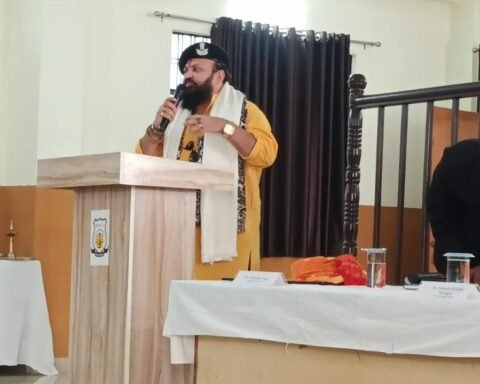The Vijay Code is a revolutionary binary cipher system developed by Wing Commander Pushkal Vijay Dwivedi (R), designed to bridge the gap between human cognition and artificial intelligence. Unlike Morse Code, it uses only two symbols — the dot (.) and dash (-) — but structures them into logical, rhythmic patterns for each letter of the alphabet. Originally conceived for military operations, it offers unmatched clarity, speed, and machine compatibility. Its intuitive design makes it ideal for AI applications, secure communications, education, and embedded systems. The Vijay Code represents a new paradigm in encoding — minimalistic, efficient, and future-ready.
Structural Simplicity and Intelligence
Vijay Code uses only two basic elements — the dot (.) and dash (-) — similar to Morse Code, yet its internal structure is far more systematic. The 26 letters of the English alphabet are arranged in logical, predictable groupings, making the code both easier to learn for humans and more recognizable to machines.

The alphabet is divided into groups, mostly of four letters:
- A to D are represented using increasing dots:
- A = .
- B = ..
- C = …
- D = ….
- E to H follow the same with dashes:
- E = –
- F = —
- G = —
- H = —-
- I to L blend dot-dash patterns:
- I = .-
- J = .-
- K = .–
- L = .—
- M to P combine double dots with increasing dashes:
- M = ..-
- N = ..–
- O = ..—
- P = . . —- (two dots followed by four dashes)
- Q to T use dash-dot sequences:
- Q = -.
- R = -..
- S = -…
- T = -….
- U to X build on the double-dash followed by multiple dots:
- U = –.
- V = –..
- W = –…
- X = –….
- Special Group (Y–Z):
- Y = .-.
- Z = -.-
This grouping offers symmetry and rhythm in encoding, which is not present in Morse Code where each character is uniquely designed without a group pattern. The visual, audible, and structural regularity of Vijay Code is what gives it an edge.
Vijay Code – Official Cipher Key
Extremely logical and memory-friendly, here is the full key of the Vijay Code:
Group 1: Dot Progression (A–D)
- A = .
- B = ..
- C = …
- D = ….
Group 2: Dash Progression (E–H)
- E = –
- F = —
- G = —
- H = —-
Group 3: Dot-Dash Combinations (I–L)
- I = .-
- J = .-
- K = .–
- L = .—
Group 4: Double Dots + Dashes (M–P)
- M = ..-
- N = ..–
- O = ..—
- P = . . —-
Group 5: Dash-Dot Progression (Q–T)
- Q = -.
- R = -..
- S = -…
- T = -….
Group 6: Double Dashes + Dots (U–X)
- U = –.
- V = –..
- W = –…
- X = –….
Special Group (Y–Z)
- Y = .-.
- Z = -.-
Cipher Advantages of Vijay Code
Morse Code, while historically significant, lacks predictability and pattern-based scaling. For example:
- A = .-
- B = -…
- Z = –..
There is no intuitive sequence.
In contrast, Vijay Code assigns:
- A = .
- B = ..
- C = …
- D = ….
This makes it mathematically predictable, which is immensely useful in:
- Machine learning: Easier pattern recognition for neural nets
- Encryption/decryption: Faster translation engines
- Cognitive memorization: Better memory retention for students and field operatives
Its rhythm-based growth also supports AI models trained on audio or binary sequences, offering high efficiency in NLP (Natural Language Processing), speech-to-text, and signal classification systems.
Application in AI and Programming
The Vijay Code is not just a cipher — it’s an encoding schema that fits perfectly with AI-driven frameworks. Its simplicity allows seamless implementation in various languages like Python, C++, Java, and MicroPython, where minimal data overhead is crucial.
In AI and ML:
- Excellent for training algorithms in pattern recognition, supervised classification, and signal interpretation.
- Its low entropy structure helps in building symbolic reasoning models and lightweight language encoders.
In Software Development:
- REST APIs built with Flask or FastAPI can encode/decode Vijay Code, allowing real-time secure messaging.
- GUI applications using Tkinter make it usable in schools and training academies.
In Embedded Systems:
- Fits perfectly in resource-limited platforms like Arduino and Raspberry Pi.
- Ideal for IoT-based communication modules in military-grade field equipment.
A Rare Algorithm that Aligns with Vijay Code: Aho-Corasick
- Use Case: Multi-pattern string matching in cybersecurity and bioinformatics.
- Why it fits: Vijay Code’s structure complements the algorithm’s state-machine-based matching.
Cognitive and Educational Utility
Another striking advantage is Vijay Code’s ability to bridge logical encoding with educational tools. Because of its pattern-based structure:
- Students find it easier to memorize
- Trainers can create rhythm-based mnemonics
- The grouped pattern of 4 (A–D, E–H…) helps reinforce memory via chunking — a psychological technique for long-term retention
This positions Vijay Code as an excellent addition to school curricula on coding, defense science, or cryptography. It aligns with national education initiatives that emphasize skill-based learning, innovation, and cognitive science integration.
Relevance in Security and Encryption
Unlike Morse Code, which is globally known and thus easily decoded, Vijay Code remains universal in structure but proprietary in logic. This makes it ideal for:
- Military messaging systems
- Secure drone-to-base communications
- Data compression in covert ops
- Personal encryption applications
It can also be integrated with AES/RSA-based encryption systems, serving as a lightweight encoding layer to obfuscate plaintext before final encryption.

Why Vijay Code Is Easy to Remember
Rhythm and Repetition
- Repetitive use of dots or dashes (e.g., D = …., H = —-, T = -….) builds natural auditory and visual rhythm, aiding retention.
Predictable Scaling
- Each subsequent letter in a group adds just one more symbol — either a dot or a dash — or shifts the sequence slightly.
Visual Symmetry
- Combinations like . -, – ., and . – – create symmetrical, balanced structures, which are easier for both humans and AI to process.
Minimal Symbol Set
- Uses only dots (.) and dashes (-) — no complex combinations or spacing rules like Morse.
Simpler = More universal.
AI-Compatible Design
- Consistency in symbol patterns allows for easier training of AI/ML models, signal processing, or algorithmic decoding.
Bi-directional Patterning
- Some groups build from left (dot-heavy), others from right (dash-heavy), offering dual memorization patterns — helpful for different cognitive styles.
Cross-group Symmetry
- Similar pattern logic is mirrored across different groups, reinforcing memory.
Example:
- B = .. and F = —
- C = … and G = —
- D = …. and H = —-
Designed for Operational Use
- Developed for military, intelligence, and AI — balancing speed, clarity, noise-resilience, and ease of encoding under pressure.
Vijay Code in AI and Programming: A Strategic Asset
1. Ideal for Pattern Recognition Algorithms
- Grouped sequences and predictable scaling help AI models detect, classify, and learn patterns rapidly.
2. Lightweight Encoding for NLP and Signal Processing
- Only two symbols = low overhead, faster transmission, better efficiency.
3. Useful in Data Compression and Secure Communication
- Perfect for secure and low-bandwidth environments such as IoT or embedded systems.
Programming Languages Where Vijay Code Can Be Useful
- Python – Ideal for ML and AI
- C/C++ – Great for embedded devices
- Java – Secure apps and Android
- R – Statistical and pattern-based experiments
- Go (Golang) – Real-time communication tools
- JavaScript – Web-based simulations and educational games
Conclusion
The Vijay Code is not merely a cipher; it is a profound innovation that unites logic, simplicity, and future-readiness into a single framework, a foundational tool for the age of artificial intelligence, cybersecurity and cognitive learning.
At the heart of this creation is Wing Commander Pushkal Vijay Dwivedi (R) — a visionary technologist, decorated IAF veteran, and thought leader whose contributions transcend conventional boundaries. His legacy is not confined to his bureaucratic office or the command room — it extends to national defence technology, AI-led transformation in security, geopolitical analysis, and religious and educational upliftment.
Whether in safeguarding borders, innovating in intelligence systems, decoding the future of warfare, or guiding youth through spiritual and knowledge-based pursuits, Wing Commander Dwivedi continues to serve as a beacon of excellence in nation-building.





